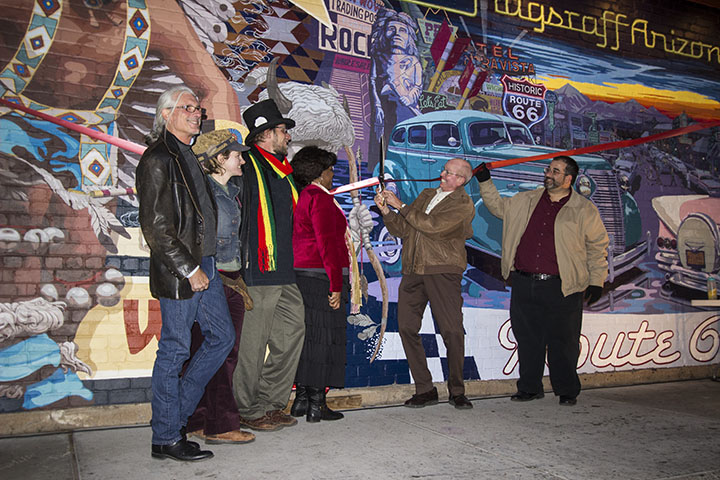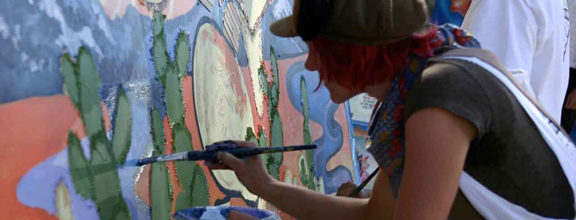Mice in the News
Route 66 Mural In Flagstaff

Travel Channel- RT 66 Mural Video
Flagstaff Cultural Partners-
"Mural Mice Nominated for 2014 Viola Award"
Lumberjack - Student News
"Community comes together for Route 66 mural unveiling"
The Noise (November 2013)- "DEDICATION"
The Mural Mice are easily remembered from the uproar of opposition over the Miller Valley Mural they completed in Prescott a few years back, and though their expression in public art has come to an abrupt halt there, they are bringing their talent and color to Flagstaff.
The new Phoenix Avenue—Route 66 Mural, located at 5. S. San Francisco Street on the South-facing wall of the Lumberyard Brewery is nearing completion.
It’s a warm October day when I stop by to chat with R.E. Wall & Margaret Dewar and to catch up with them since the last time we interviewed earlier this year. At that time only the base layers of paint could be seen, with the beginnings of details appearing here and there. Now, one week shy of the mural’s dedi- cation ceremony the mural is alive with color, ranging from sepia-tones at the edges to full, bright neon at its center. While Ms. Dewar paints, I talk with Mural Mice founder R.E. Wall, who speaks for Mural Mice Universal.
“We were able to put together a mural that gives a little piece of the spirit of each of the ages,” Mr. Wall says. “In doing the Route 66 mural we’ve learned a lot about the town. We studied from the Cline archives at NAU, public libraries around the state, and the Internet. We also spoke with quite a few historians and lo-
cal residents. The road lived for about 60 years in its full glory. We were able to put together a chronological storyboard that offers a little piece of the spirit of each of the ages in ten- year increments, from 1926 - 1985. Route 66 books and even modern travelers tell us that it was a virtual microcosm of American culture all comprised into one great road stretching from Chicago to L.A.”
Mr. Wall tells me about the scenes in the mural. “The All-Indian Pow Wow, lasted 50 years. It took place from 1929 to 1979. The all- Indian Pow Wow took place during the July 4th weekend.” he says. “It drew Native Americans from all over the Southwest and Northwest. They would travel across vast distances on wagons with rubber wheels, being pulled by horses all the way down to Arizona for this big gathering of the tribes. It actually doubled the number of people in town. Upwards of 10,000 people would converge in Flagstaff quite suddenly. They would pitch tents up on Mars Hill and would base themselves there with campfires and cooking throughout the nights. During the days, they would participate in parades and dances along Route 66. It was quite the treat to come down and watch the natives dance in their regalia and the pageantry. Peo- ple would seat themselves on top of the buildings and along the street to see the parades. The great All-Indian Pow Wow was apparently quite the thing to experience.”
“In the center of the mural we have a neon strip that is both Phoenix Avenue and the Route 66 strip at twilight when the neon is seen the best. Classic cars in the foreground help to define the era. The kitsch road signs of plastic Indians and odd attraction signs line the road on the way out of town. In the 1940s when World War II started, many of the vehicles on the road were military trucks and transports. They drive past the Navajo Weap- ons Depot and past a local mom and pop service station. Navajo shepherds are mov- ing a large flock of Churro sheep across the highway. Dust bowl clouds loom ominously in the distance emitted from the smokestack of an old coal train engine pulling up to the lumberyard.”
I was also able to talk with Ms. Dewar that afternoon. She tells me about her experience this summer painting in Flagstaff.
Ms. Dewar tells me about her impression of Route 66. ““This mural is an expression of what we as Americans have held Route 66 to symbolize. The history of Route 66 has been romanticized, the narrative is almost a Hol- lywood myth, she says. “History is meant to explain the past, but it also reflects the values of today. The historic narrative of Route 66 glo- rifies the ideas of the ‘Wild West,’ the working man’s struggle, car culture and the freedom of the open road. The meaning we have given the road reflects the American values of in- dividualism, self-realization, and patriotism. Route 66 has gained almost celebrity status, but mostly since it was decommissioned. With that in mind, there is tremendous nostalgia as- sociated with the narratives of Route 66 that tell of a simpler time in America, the ‘good old days’ as it were. Nostalgia can almost be like amnesia, people forget what life was really like. The stories of Route 66 often exclude the less desirable memories of prejudice against Native Americans and other races, and the hardships people faced when the road was closed.”
This First Friday ArtWalk the final expression of the Mural Mice Phoenix Avenue/Route 66 mural will be revealed in a dedication ceremo- ny. “We’re inviting the public out to see it with- out trees in front of it, without cars in front of it, in the night time, lit up with beautiful amber light,” Mr. Wall tells me. “We’re inviting people to come out November 1, at 5PM. The mayor is coming out, the Vice Mayor, historians, and relevant art community members, including
John Tannous of Flagstaff Cultural Partners, are going to come out and speak for the first hour from 5PM to 6PM. And at 6PM the music’s going to begin. We’re having Viola and the Brakeman open up for Summit Dub Squad who is bringing Casper to play with them as well. It’s going to be a really exciting show.”
The Phoenix Avenue/Route 66 Mural was made possible by the City of Flagstaff Beautifi- cation and Public Art Committee and funding from the BBB taxes. The Dedication Event on November 1 is possible thanks to the volun- teer support and generous donations of com- munity members and local businesses. Mural- Mice.com



